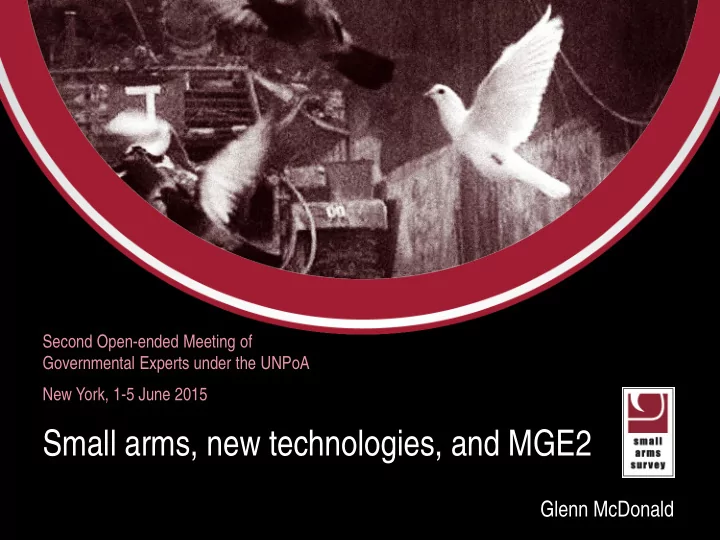

Second Open-ended Meeting of Governmental Experts under the UNPoA Small Arms Survey 2012 New York, 1-5 June 2015 Small arms, new technologies, and MGE2 Moving Targets Glenn McDonald
MGE2 (June 2015) SMALL ARMS SURVEY
Second Open-ended Meeting of Governmental Experts (MGE2) Recent developments in small arms manufacturing, technology and design marking of polymer • frames modular weapons • design 3D printing • new technologies for • improved control
Marking of polymer frames
Polymer: pros and cons • Advantages: lower weight and cost, improved user-to-weapon interface • Disadvantages: more difficult to mark polymer parts durably (ITI, para. 7) • Consequence: arms traffickers seeking to make a polymer gun untraceable can simply remove the serial number on the frame
Problems (and solutions) • Metal tags, stamped with the weapon’s serial number, can be embedded in the frame • But traffickers can remove the tag • Solution: embed the tag in such a way that any attempts to remove it will damage the frame • Problem: fitting post-manufacture markings on tags of fixed size
Questions for MGE2 • Marking methods for polymer parts (laser engraving, micro- percussion/dot-peen) • Depth and placement of markings applied to polymer parts • Use of metal tags (depth of insertion, plate dimension and location) • International cooperation and assistance (diffusion of relevant marking technologies, new forensic techniques, etc.)
Modular weapons design
The FN SCAR ‘family’
Modular weapons: basic features • Split receiver architecture • Core (fixed) section • Reconfiguration of the rifle to meet different operational needs (changing the calibre, barrel, etc.) • Exchange of parts from the same or related models • Full modularity: complete reconfiguration, including calibre • Family approach: same model produced in different versions, each with its own calibre; reconfiguration, except for calibre
Challenges • Key challenge: tracking the weapon throughout its life cycle despite changes in configuration • Distinguishing the weapon from its major components following reconfiguration (conflicting serial numbers) • Marking of additional info. (e.g. calibre) (ITI, para. 8a)
Questions for MGE2 • Identification of a ‘control component’ (upper or lower receiver) • What identifying info. to mark on the control component • Whether and how other components of the rifle should be marked • Whether and how records associated with the weapon should try to account for its potential configurations
3D printing SMALL ARMS SURVEY
3D-printed firearms: advantages - speedy development of designs and prototypes - reduced material use - easier production of complex products - inexpensive customization
3D printing today • Mostly used to produce firearm components & accessories • Complete 3D-printed metal firearms are not yet commercially viable (e.g. Solid Concepts Inc. 1911). • The increased availability of relevant materials, software, and hardware has spurred the 3D printing of polymer firearms. • Production of the first functioning 3D-printed firearm in early 2013 (Defense Distributed ‘Liberator’ handgun). • Initial models could fire only 1 to 11 rounds, but improved designs are now under development.
Examples of 3D-printed firearms Defense Distributed ‘Liberator’ Solid Concepts 1911 DMLS
Policy implications In general, national, regional, and international norms govern 3D-printed firearms in the same way as they govern traditional firearms. • UN Small Arms Programme of Action (PoA) • International Tracing Instrument (ITI) • UN Firearms Protocol • Arms Trade Treaty • National legislation
Law enforcement challenges Problem: it is often more difficult to apply existing norms to 3D-printed firearms. Challenges: • Controlling unlicensed production • Enforcing restrictions on the flow of weapons-related information over the Internet • Limited application of forensics techniques • Routine destruction of cheap, untraceable 3D-printed guns by criminals • The risk of catastrophic weapons failure (consumer safety)
New technologies for improved small arms control SMALL ARMS SURVEY
New technologies • Not new - widely used in other industries • Marking, record-keeping, and tracing • Stockpile management and security • End-use control Intelligent Road/Rail Information Server
New marking technologies • 2D data matrix codes • Microstamping • Improvements in associated scanning technology
New tech for stockpile management Functions: • Access control • Inventory management (increased data accuracy) • Monitoring and protection of weapons in transit Technologies: • Biometric gun safes • RFID tags and strips • Increased computing power and other IT advances
New tech for end-use control Electronically controlled safety mechanisms (ECSMs): • Biometric (e.g. palm print scanner) • Token-based (e.g. RFID- tagged wrist watch) • Concerns about reliability
Barriers to implementation • Cost (databases and networked IT) • Questions about reliability • Sharing info. stored in a new format • Opposition from political and consumer groups Afghan officers at an electronic inventory • Slow pace of change in the management training session, June 2011 firearms industry
The limitations of technology Top: Government storage lockers Bottom: Keys and firearms improperly stored in government vehicles
thank you Small Arms Survey 2012 www.smallarmssurvey.org Moving Targets SMALL ARMS SURVEY
Recommend
More recommend